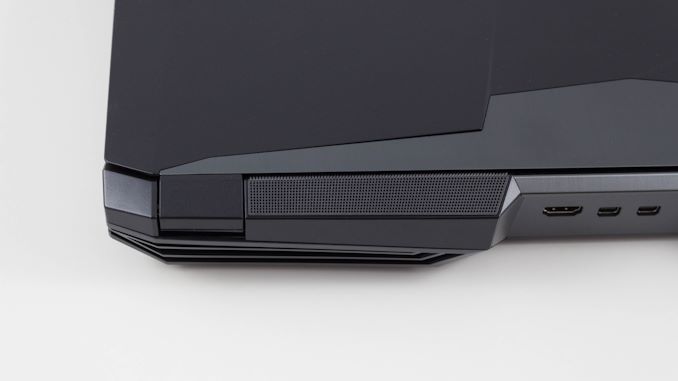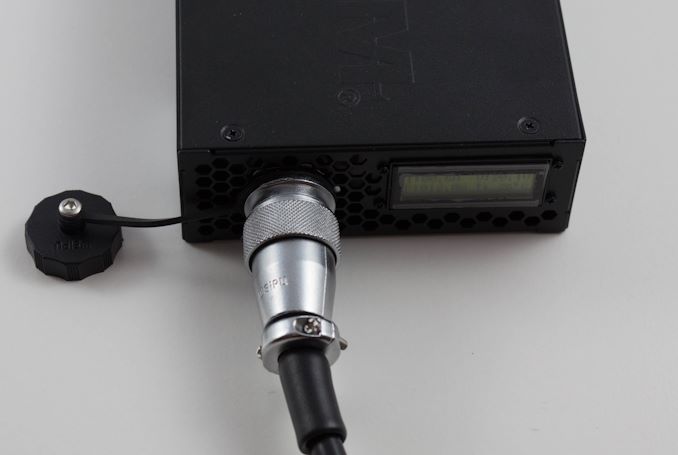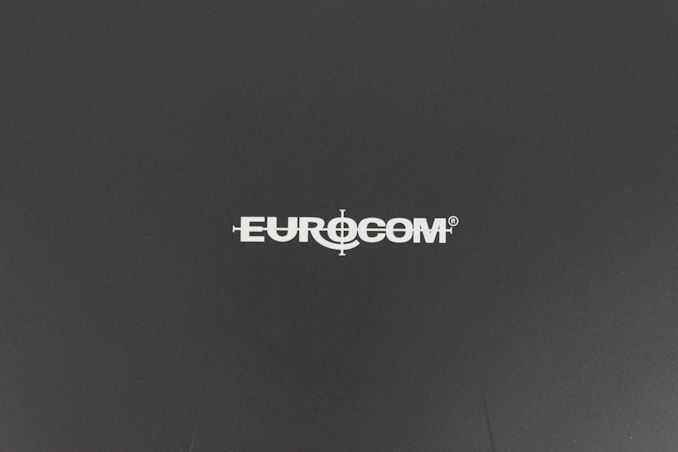The Eurocom Sky X7C (Clevo P775TM1-G) Gaming Laptop Review: True Desktop Replacement
by Brett Howse on August 5, 2019 8:00 AM ESTFinal Words
If you need absolute portable performance, look no further than the Eurocom Sky X7C. The latest generation of the Clevo based Desktop Replacement notebook from Eurocom offers fantastic performance compared to any other notebook around. 17.3-inch gaming notebooks tend to be desk-bound anyway, so this machine just goes all the way and becomes a small form factor desktop with a display and keyboard integrated.
What has perhaps been the most impressive in terms of performance is just how much quicker this notebook is than the last desktop class notebook we tested, which featured an at-the-time very speedy Core i7-6700K. Although Intel has been stuck with their Skylake architecture for much too long, the latest generation Coffee Lake processors are dramatically faster, partially based on the extra cores at play, and partially due to the much higher frequencies offered with the refinement to 14 nm over the last couple of years.
It is likely no surprise that this Eurocom Sky X7C walks all over the competition in terms of CPU performance thanks to the Core i9-9900K. If you want even more performance, Eurocom will assist by delidding and providing a wide-range of options for thermal paste and other tweaks. The included software makes it easy to tweak the CPU performance as well, and you can overclock if you’re into that sort of thing. The notebook seems to be able to handle the extra power demands of a desktop CPU without any real issues, other than the added noise. There was no thermal throttling detected under load at all.
The RTX 2080 continues to be the quickest GPU available in a notebook, and thanks to the extra CPU grunt it pulls its lead even further in games that were CPU bound, such as Far Cry 5. In GPU bound games, performance is about the same, as expected. It’s possible NVIDIA will offer the Super range in notebooks at some point in the future, but it does seem unlikely with the extra power draw the Super cards require, so for the foreseeable future, the RTX 2080 will likely rule the roost.
One of the biggest benefits of choosing a notebook such as this is the customization available. Most notebooks come in one of several different configurations, and what you see is what you get, but Eurocom offers a massive number of options to configure the notebook exactly as you need it, whether for absolute performance, or to fit in a budget.
Going into this review, there weren’t going to be a lot of surprises in terms of the notebook design and construction. We’ve seen Clevo based notebooks in the past, and the thick plastic exterior, the average keyboard and trackpad, and the somewhat plain design are all part and parcel of the experience, and this latest generation offered no surprises there. There were some nice new design tweaks though, such as the speakers being available on the rear hinge, allowing them to be used when the notebook is closed, but compared to the all-aluminum chassis of most of the big gaming laptop manufacturers, and things like the per-key RGB SteelSeries keyboards that MSI employs, the Clevo-based unit can’t measure up. However where it surpasses those devices is not only in outright performance, but performance per dollar as well.
If there was one major disappointment with the Eurocom Sky X7C, it was the 2560x1440 120 Hz TN display, but this was a conscious choice to see how it stacks up against the impressive 1920x1080 144 Hz IPS we’ve seen in a couple of other notebooks already. Clearly the latter panel is a better choice, especially with G-SYNC, and the RTX 2080 can game at 1920x1080 with framerates to keep the 144 Hz panel going nicely. If you do want a higher resolution for desktop applications, Eurocom also offers a 3840x2160 60 Hz IPS which would fit that bill, but if you’ve not had a chance to game on a high-refresh display, it really is a great experience especially when you have the hardware to power it.
Overall, Eurocom offers a great package in the Sky X7C. It offers the most performance possible in a single GPU notebook, at a price well below most of the competition. It is completely function over form, and it fills that job perfectly. As an owner, you also get the benefit of a lot of expandability and upgradability that you don’t get with a typical notebook, from not only the hard drives and memory, but also being able to change the CPU, and even the GPU, although not quite as easily, since you’d have to get a compatible MXM3 card, but they are available. If you laugh in the face of aluminum laptops, shun the thin and light crowd, and just want absolute performance, definitely check this model out. You won’t be disappointed.














46 Comments
View All Comments
p1esk - Monday, August 5, 2019 - link
I love the option of 1440p at 120Hz! Hope to see it in normal laptops (perhaps new MBPs can lead the way to improved refresh rates?)HollyDOL - Monday, August 5, 2019 - link
Since the article title talks about 'true desktop replacement', could we get price and performance comparison to desktop with "same" parts? ie. DDR4-3000 + 9900K + RTX 2080...Brett Howse - Monday, August 5, 2019 - link
Our GPU bench is currently an i9-9900K as well. As a comparison I got 116 FPS on Shadow of the Tomb Raider, and Ryan got 114.6 with the desktop version, so the performance seems similar. Unfortunately we don't have a lot of overlap on our tests though because Ryan is able to keep GPUs and benchmark them on new suites whereas laptops have to go back to the manufacturers so I don't rotate the tests as heavily since every time I add a new test it starts out with zero results to compare against.Is there a particular title you'd like to see compared against other than Shadow of the Tomb Raider?
HollyDOL - Tuesday, August 6, 2019 - link
nice, thanks...Compile Chromium (time) test would be nice...
or in general anything that puts the machine under high sustained stress for longer period (45mins+)...
craz8 - Monday, August 5, 2019 - link
I have one of these laptops - a Sager branded one.It really is quite heavy, and the 330W power brick is equally beefy - I selected the RTX 2070 to avoid needing double power bricks. I do use this on my lap, but the power plug at the back falls out a lot in this configuration. It's not a very secure connection. Since it's at the back, the only way to notice is that suddenly the CPU is running at 1.3Ghz instead of 4+
I almost always run this in Quiet mode, as the fans are almost silent in this mode. When I'm stressing the machine, the CPU clocks down to about 3.4-3.6 Ghz, which is still good enough for the work I do on it. If I run in performance mode, the things I run go a little faster, but the fan noise is not worth the extra speed.
There really isn't enough cooling for Nvme drives. Even small amounts of writing to them immediately pushes the temps to 90+, and there's no room for extra heatsinks to help with this.
I have the 4K screen, which seems pretty good, but if you dual boot into a Linux OS, the bootloader screen is hilariously small, and some versions of Linux have poor scaling options
I mostly use this on my desk, and it (or Windows 10) really doesn't like my CalDigital TB3 dock. Luckily, everything plugs into the chassis (unlike recent Apple hardware)
I don't play games on this, so barely use the GPU (RTX 2070). I'd love to have options to push more power and cooling to the CPU whilst scaling them back to the GPU without having to poke at the values manually.
Overall, I like mine, but it does have quirks.
Alistair - Monday, August 5, 2019 - link
I think you'd be much better off with a (I hate to say it) nVidia creator laptop, or a 9880H/9980HK laptop with a 120/144hz Gsync IPS screen. We need a comparison with Clevo of the MSI Stealth and Raider and Titan.https://www.newegg.com/matte-black-with-gold-diamo...
Brahman05 - Monday, August 5, 2019 - link
I have sager's version of the x9e2 with a 7700k and 1080sli and the same 1440p panel, and the panel is both one of the best and worst parts in the thing. One thing not mentioned in this article is the gtg does not really support the refresh rate, but by reporting a 120hz refresh it at least still cuts down on input lag. I really have no complaints though. When I got it I had a mobile lifestyle and had the money for it, my only two real gripes are ZEN and RTx. Not 3 months after I got the thing AMD goes and makes 8c16t a thing and even if the architecture is pretry much the same from the 6700k to the 9900k the productivity of the same class chip is now double. And with RTX going to NVLink for an sli bridge Nvidia has axed mobile sli due to the complexity involved in producing that type of connector. So this X7c is really the way to go anymore. Damn you progress!LsRamAir - Monday, August 5, 2019 - link
No Overclocking detail... bahhhh! Pushing these DTRs to the max that their cooling allows for is what at least half of their buyers do... Next time, yes please! (Especially in the wake of similarly spec'd DTR machines burning out under mild OC's, which SHOULD NOT HAPPEN, it would be nice to know if this SKY is also part of the bad choices group.)peteraustin - Tuesday, August 6, 2019 - link
Amazing article https://www.anandtech.com/ you should definitely read it in your spare timehennes - Tuesday, August 6, 2019 - link
I recently got this laptop as a replacement for a 10 1/2-year-old laptop. I wanted a full-sized keyboard, which means 17” or larger. Potable means 17” really it the limit. And 17” is perfect for 2k screens.The Sky X7 was one of the few which offered that and it had all my desired other connectivity (multiple NVME, multiple DP out, a few fast USB ports, thunderbolt, …
What really was surprising is how few other there are. Many with low res displays (1920x1080) which makes sense for gaming. Some with 4K displays future proof but quite small on a 17” display.
That made the X7C almost the only sensible choice.
And from an engineering view the thicker than average body was also very attractive. As were the looks. Form over function simply looks good, while designed stuff tend to look odd and twisted to me.
The only thing it lacks for me is more battery capacity. Lugging the large charger around is not fun and two battery slots (or 2x 80) for airplane use would have been my choice if it was offered.